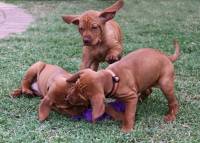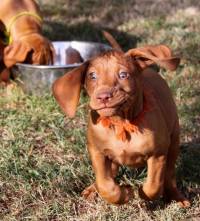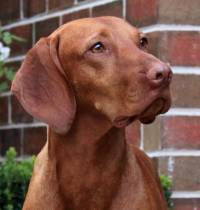Hungarian Vizsla and Hungarian Wirehaired Vizsla
 Hungarian Postage Stamp
Hungarian Postage Stamp
The Hungarian Vizsla is one of Hungary's National dog breeds. His unique history began in Asia around 900 AD as the yellow hunting dog that accompanied Hungary's first settlers, the Magyar. Ever since, the pride of the Hungarian people has ensured this National dog survived political wars, turmoil, ever changing borders and other man made disasters to become the distinctive Hungarian pure breed known across the modern world.
History of the Hungarian Vizsla
 Yellow Dog 15th Century
Yellow Dog 15th Century
Hungary was originally settled around 900 AD when nomadic Magyar tribes migrated from Asia. They brought with them their Livestock Guardian Dogs, the Komondor and Kuvasz which guarded their flocks. Stone etchings from around this time show they were also accompanied by a dog which hunted mainly birds and was used in conjunction with the net for falconry.
 Hungarian Postage Stamp
Hungarian Postage Stamp
The name 'Vizsla' dates back to 1100 AD to a small hamlet. The 'Illustrated Vienna Chronicle' written by the Carmelite Frairs in 1357 has five paintings of hunting scenes one of which shows a yellow hunting dog with a Viszla type anatomy locating and flushing a bird and mentions the Vizsla by name. The Hungarian National Record Office in Budapest also has some letters written in 1515 and 1563 mentions the yellow Vizsla used in falconry and boar hunting[1].
 Hungarian Vizsla pups
Hungarian Vizsla pups
By the early 1700's when fowling and the sport of falconry was slowly giving way to firearms and the Vizsla was already well known as a hunting dog. But changes of borders, constant wars and the importation of English hunting breeds like English Setters and Pointers played havoc with the original yellow dog of Hungary.
 Hungarian Vizsla pup
Hungarian Vizsla pup
The Hungarian Vizsla becomes a Pure Breed
The first modern documented resurrection was in 1920 with the FCI recognising the Hungarian Vizsla as a separate breed in 1936. By 1943 it was recorded that 5,000 Vizslas were registered in Hungary. But the Second World War and the consequent Russian Communist occupation of Hungary played havoc with the Vizsla again in its country of origin. Fortunately sufficient numbers, together with their owners had already fled to countries outside Hungary. So partly due to the Hungarian's national pride, the Vizsla we know today survived[2].
History of Hungarian Vizsla in Australia
 Hungarian Vizsla wins Crufts 2010
Hungarian Vizsla wins Crufts 2010
The Hungarian Vizsla was first introduced into Australia in 1973[3]. Australian breeders proved their skill when Aust Ch and English Show Champion Hungargunn Bear itn Mind ("Yogi") was produced. This famous Vizsla not only enjoyed a remarkable show career in UK becoming an English Show Champion, but became the only Vizsla to win Best Exhibit in Show at Crufts, the world's largest dog show which he did in 2010.
The Hungarian Wirehaired Vizsla
 Hungarian Wirehaired Viszla
Hungarian Wirehaired Viszla
The Hungarian Wirehaired Vizsla is a modern breed, recognized by the FCI in 1966 when some hunting men crossed the German Wirehaired Pointer to the Hungarian Vizsla to improve its hunting capabilities. The Wirehaired Vizsla ideally has a wiry double coat with the outer coat 2 - 3 cms (around one inch) long with a water repellent undercoat.
The Wirehaired Vizsla also has a more robust construction than the Vizsla, evidenced by some extra thickness in the Wirehaired Vizsla's tail and ears. Additionally owners of Wirehaired Viszlas say they are less excitable than the Vizsla, especially in the modern home environment.
 Hungarian Vizslas
Hungarian Vizslas
The Hungarian Vizsla Today
The Hungarian Vizsla is versatile gundog capable of working in the field and water. He has smooth single coat, and is an elegant medium sized russet to dark sandy gold coloured gundog measuring approximately 54 - 64 cms (around 21 - 25 inches) at the shoulder.
 Hungarian Vizsla
Hungarian Vizsla
The skull moderately wide with a slight occiput. A small groove runs between the eyebrows to the moderate stop. His brown nose should be well developed and broad with nostrils as wide as possible. The muzzle is strong with the bridge of the nose straight and the lips tight fitting without pendulous flews and the strong muscular jaws closing in a normal scissors bite. The brown oval eyes harmonise with the coat colour and are of medium size. The ears are about three-quarters of the length of the head. They are a rounded 'V' in shape and have thin, soft leathers which hang close to the cheeks in a medium set on which varies according to the dog's mood.
 Hungarian Vizsla
Hungarian Vizsla
The dry neck should generally balance the dog. The withers are pronounced and the shoulders long, sloping and flat. The upper arm is as long as possible with the elbows fitting close to the body. The forelegs are long, straight and sufficiently muscled with strong but not coarse bone. When viewed from the front the forelegs should be straight and parallel so that in profile they appear to be vertical and placed well under the body. The pastern is short with only a slight slope. The feet are almost oval with strong brown nails and tough slate grey pads.
 Hungarian Vizsla on Point
Hungarian Vizsla on Point
The chest is broad and with the forechest extending to the elbow joint and the sternum extending as far back as possible. The ribs are moderately arched with the last rib carried well back so the underline arches towards the rear and is only slightly tucked up. The straight back should be strong and taut together with the short, broad loin which may be just slightly arched. The croup is broad and of sufficient length to slope slightly to the tail. So the tail is set on a little lower than the firm, level topline.
 Hungarian Vizsla
Hungarian Vizsla
When viewed from behind the hind legs should appear to be straight and parallel. The upper thigh and lower thighs are long, muscular and almost equal in length with a well angulated stifle separating them. The hock is short, strong and sinewy. On the move the tail, which should be covered by dense hair, can be raised up to the level of the topline. The Hungarian Vizsla moves with an animated, light-footed trot, elegant and far-reaching gait with adequate reach and drive.
References and Further Reading
Hot off the Press! Jane has just published a book 'Gundogs Unveiled'. Information on our sister website: www.Rangeairevision.com
[1] Gay Gottlieb, 'The Hungarian Vizsla' Published by Nimrod Book Services (Fanciers Supplies Ltd) Liss, Hants, GU33 7PR UK, ISBN 0 947647-09-0 Chapter 1, Hungarian Vizsla's History Pages 3 - 8.
[2] B.C.Boggs, 'The Vizsla' Published by Glenbrier Publishing Company USA ISBN 0-9608838-0-0 Revised Edition 1982 'History' Pages 14 - 31
[3] Faye Harris, 'The Hungarian Vizsla in Australia' Self Published 1992 ISBN 0 646 007831 Chapter 2 'The Hungarian Vizsla in Australia' Page 9